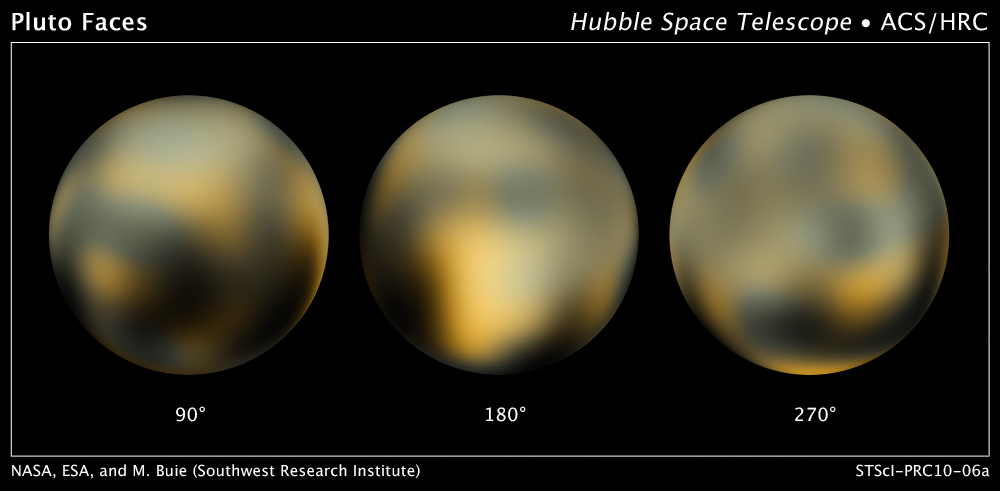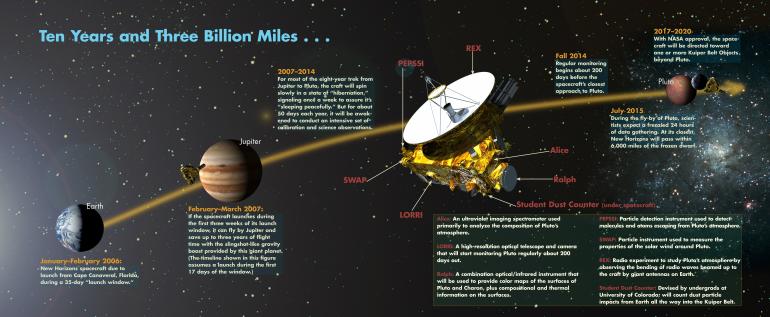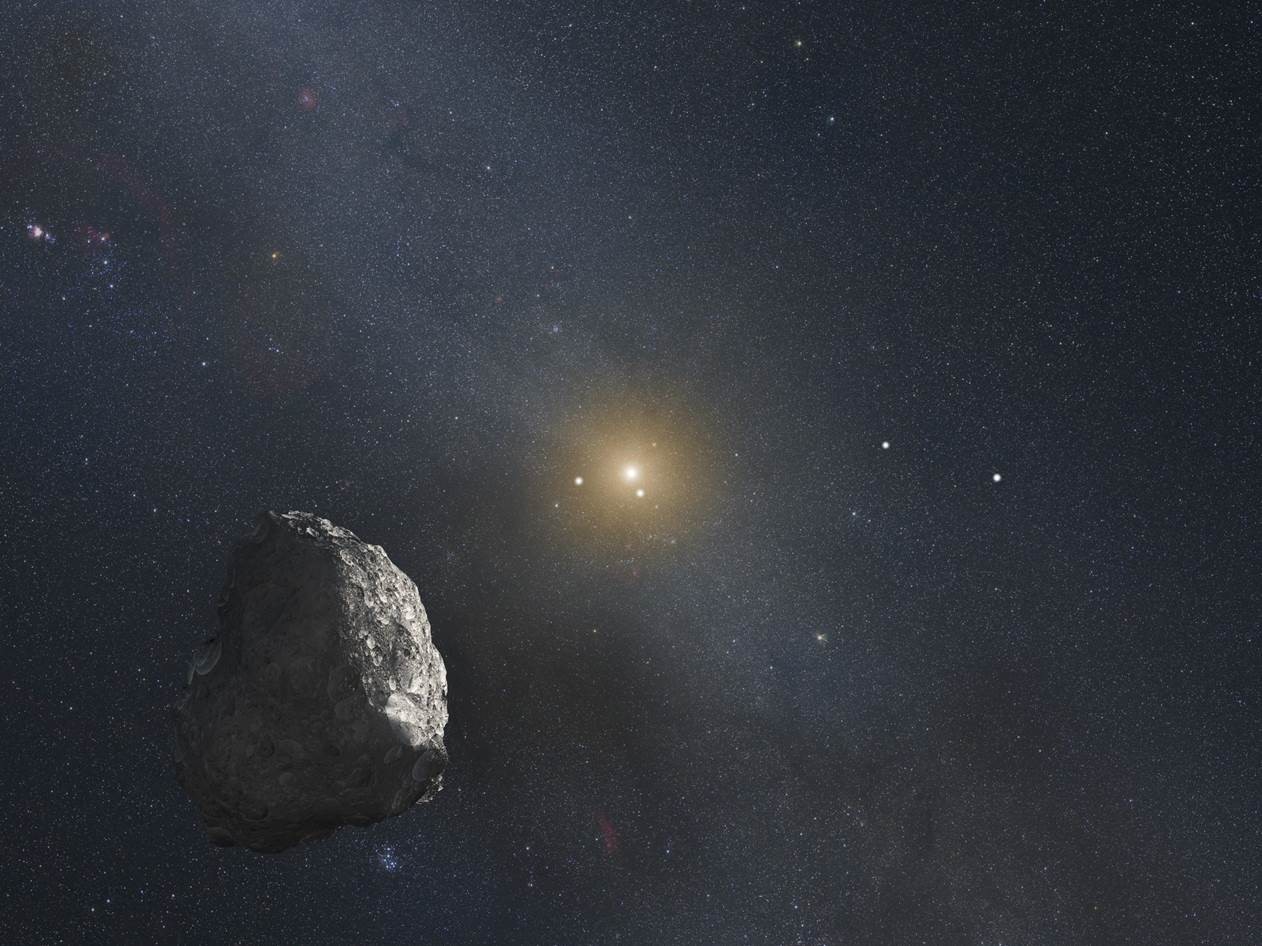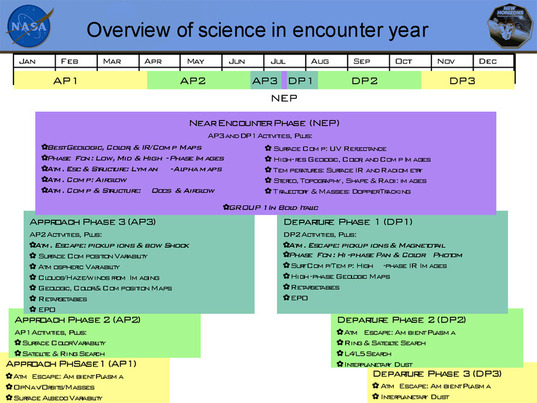It looks like you're using an Ad Blocker.
Please white-list or disable AboveTopSecret.com in your ad-blocking tool.
Thank you.
Some features of ATS will be disabled while you continue to use an ad-blocker.
38
share:
Similar to the recent thread by "eriktheawful" stating that the Dawn spacecraft nearing its target of the asteroid Ceres, another space
probe is nearing its target destination -- The New Horizons spacecraft is getting near to Pluto after almost 9 years in space.
Granted, it will not be reaching its closest encounter with Pluto until July of 2015, but it is now near enough to the dwarf planet that mission planners will be "waking up" the spacecraft out of hibernation this coming Saturday (December 6) in preparation for it to begin to do its scientific mission, which will begin in January, ahead of July's close encounter fly-by of Pluto.
By the way, to give you some idea of how long New Horizons has been on its way to Pluto: when New Horizons was launched, Pluto was still our ninth planet! To clarify, the spacecraft has not been in hibernation the entire time since launch; it's been awoken several times before (and put back to sleep). This will just be the last time it will be awoken until it reaches Pluto.
Here are some Hubble images of Pluto. don't be fooled by the perfectly round images you see. This is not a traditional image of Pluto, but rather a combination of images (where the entire dwarf planet is just a few pixels across) that have been run through a computer process of artificially creating a higher resolution image:

Image Source and more information:
Hubble Maps of Pluto Show Surface Changes
Pluto may turn out to be a very interesting place. From the little we can see of it, it does seem to exhibit surface changes as its longs seasons change. Pluto is headed for its winter season (which will last for about 100 Earth years), and it appears that its atmosphere is beginning to freeze and fall to the surface. New Horizons will hopefully give us some information about that atmosphere, and the reason for the visible seasonal changes.

Sources:
New Horizons Reaches Pluto, NASA To Wake Up Spacecraft Saturday
NASA/New Horizons Mission Home Page
After it Passes by Pluto, Then What?
New Horizons is planned to fly past Pluto in July. It will not be reaching orbit around Pluto and staying, due to the speed of the spacecraft, the lack of the fuel required to slow down, and the lack of the ability of Pluto's gravity to grab it. So what happens to the spacecraft then?
The plan is for New Horizons to go off into the kuiper belt and investigate other interesting targets there. Mission planners have been looking for candidates in the kuiper belt that New Horizons could study, and they have found a few:
 This is an artist’s impression of a Kuiper Belt object (KBO), located on the outer rim of our solar
system at a staggering distance of 4 billion miles from the Sun. A HST survey uncovered three KBOs that are potentially reachable by NASA’s New
Horizons spacecraft after it passes by Pluto in mid-2015
This is an artist’s impression of a Kuiper Belt object (KBO), located on the outer rim of our solar
system at a staggering distance of 4 billion miles from the Sun. A HST survey uncovered three KBOs that are potentially reachable by NASA’s New
Horizons spacecraft after it passes by Pluto in mid-2015
Image Credit:
NASA, ESA, and G. Bacon (STScI)
Source and more information:
NASA’s Hubble Telescope Finds Potential Kuiper Belt Targets for New Horizons Pluto Mission
Granted, it will not be reaching its closest encounter with Pluto until July of 2015, but it is now near enough to the dwarf planet that mission planners will be "waking up" the spacecraft out of hibernation this coming Saturday (December 6) in preparation for it to begin to do its scientific mission, which will begin in January, ahead of July's close encounter fly-by of Pluto.
NASA will wake New Horizons on Saturday, the last of 18 different hibernation periods, but the space agency will conduct a series of tests before the spacecraft begins exploring Pluto on Jan. 15, according to NASA's The PI's Perspective blog.
"New Horizons is healthy and cruising quietly through deep space -- nearly three billion miles from home -- but its rest is nearly over. It’s time for New Horizons to wake up, get to work, and start making history." Alice Bowman, New Horizons mission operations manager at the Johns Hopkins University Applied Physics Laboratory, said in a statement.
By the way, to give you some idea of how long New Horizons has been on its way to Pluto: when New Horizons was launched, Pluto was still our ninth planet! To clarify, the spacecraft has not been in hibernation the entire time since launch; it's been awoken several times before (and put back to sleep). This will just be the last time it will be awoken until it reaches Pluto.
Here are some Hubble images of Pluto. don't be fooled by the perfectly round images you see. This is not a traditional image of Pluto, but rather a combination of images (where the entire dwarf planet is just a few pixels across) that have been run through a computer process of artificially creating a higher resolution image:

The Hubble images are a few pixels wide. But through a technique called dithering, multiple, slightly offset pictures can be combined through computer-image processing to synthesize a higher-resolution view than could be seen in a single exposure. This series of pictures took four years and 20 computers operating continuously and simultaneously to accomplish.
Image Source and more information:
Hubble Maps of Pluto Show Surface Changes
Pluto may turn out to be a very interesting place. From the little we can see of it, it does seem to exhibit surface changes as its longs seasons change. Pluto is headed for its winter season (which will last for about 100 Earth years), and it appears that its atmosphere is beginning to freeze and fall to the surface. New Horizons will hopefully give us some information about that atmosphere, and the reason for the visible seasonal changes.

Sources:
New Horizons Reaches Pluto, NASA To Wake Up Spacecraft Saturday
NASA/New Horizons Mission Home Page
After it Passes by Pluto, Then What?
New Horizons is planned to fly past Pluto in July. It will not be reaching orbit around Pluto and staying, due to the speed of the spacecraft, the lack of the fuel required to slow down, and the lack of the ability of Pluto's gravity to grab it. So what happens to the spacecraft then?
The plan is for New Horizons to go off into the kuiper belt and investigate other interesting targets there. Mission planners have been looking for candidates in the kuiper belt that New Horizons could study, and they have found a few:
Peering out to the dim, outer reaches of our solar system, NASA’s Hubble Space Telescope has uncovered three Kuiper Belt objects (KBOs) the agency’s New Horizons spacecraft could potentially visit after it flies by Pluto in July 2015.
The KBOs were detected through a dedicated Hubble observing program by a New Horizons search team that was awarded telescope time for this purpose.

Image Credit:
NASA, ESA, and G. Bacon (STScI)
Source and more information:
NASA’s Hubble Telescope Finds Potential Kuiper Belt Targets for New Horizons Pluto Mission
edit on 12/3/2014 by Soylent Green Is People because: (no reason given)
i wonder if their last act before it gets too far out will be to aim it towards a distant star just as a symbolic thing?
originally posted by: stormbringer1701
i wonder if their last act before it gets too far out will be to aim it towards a distant star just as a symbolic thing?
I would love to see what our Sun looks like from out there.
If they have the opportunity to turn the cameras towards our Sun with only minimal impact on any of the probe's stated scientific missions, I would like to think that they would.
edit on 12/3/2014 by Soylent Green Is People because: (no reason given)
Exciting News! I dont expect them to find anything abnormally interesting with Pluto, however some High Res images would be uber cool.
This is indeed exciting news. I have a feeling there's going to be a few surprises in store. When will NH start taking photos?
a reply to: darthphilae
Is it actually taking photos though?
It will be around July when it is within distance to start experiments according to the article.
Is it actually taking photos though?
It will be around July when it is within distance to start experiments according to the article.
For some reason I'm fascinated with Pluto.
Maybe it's just the "underdog" syndrome.
Hope they find something really cool they weren't expecting.
Maybe it's just the "underdog" syndrome.
Hope they find something really cool they weren't expecting.
these are the good kinds of threads in this place. YAY FOR SPACE! #Caps
originally posted by: darthphilae
This is indeed exciting news. I have a feeling there's going to be a few surprises in store. When will NH start taking photos?
originally posted by: Collateral
a reply to: darthphilae
Is it actually taking photos though?
It will be around July when it is within distance to start experiments according to the article.
The New Horizons spacecraft has three cameras on it. It has already taken lots of photos of Jupiter when it flew by in I think 2007. It's also taken a few of Pluto and Charon already. Regular imaging starts on January 25 for optical navigation. Resolution with the LORRI instrument will surpass Hubble sometime around April/May.
Most of us are expecting the unexpected. For example, did anyone predict cantaloupe terrain on Titan? Nope ... but now we "expect" it on Pluto. What about cryovolcanism? The largest crater (think Mimas's Herschel "Death Star" crater)? What about the shape -- could it contain a fossilized bulge indicative of a now-frozen sub-surface ocean? Etc.
There is a live stream from The Planetary Society starting soon and running for an hour.


Based on past experience with previous spacecraft/planet encounters, I can almost guarantee that there will be plenty of surprises when New Horizons
reaches Pluto.
edit on 8-12-2014 by Mogget because: (no reason given)
new topics
-
FLORIDA Sues Biden-Harris FEMA for Denying Disaster Assistance to Homeowners with TRUMP Signs.
US Political Madness: 13 minutes ago -
Turns out, they planned to go after P-nut.
US Political Madness: 4 hours ago -
Sick sick sick
Social Issues and Civil Unrest: 10 hours ago
top topics
-
Comcast dumping MSNBC
Mainstream News: 12 hours ago, 19 flags -
President-elect TRUMP Picks MATT GAETZ for his ATTORNEY GENERAL - High Level PANIC Ensues.
2024 Elections: 16 hours ago, 17 flags -
Turns out, they planned to go after P-nut.
US Political Madness: 4 hours ago, 14 flags -
Sick sick sick
Social Issues and Civil Unrest: 10 hours ago, 7 flags -
FLORIDA Sues Biden-Harris FEMA for Denying Disaster Assistance to Homeowners with TRUMP Signs.
US Political Madness: 13 minutes ago, 1 flags
active topics
-
Over 1,100 Migrants Arrived in First 10 Days of Labour Government
Social Issues and Civil Unrest • 441 • : Oldcarpy2 -
Turns out, they planned to go after P-nut.
US Political Madness • 16 • : WeMustCare -
WATCH LIVE: US Congress hearing on UFOs, unidentified anomalous phenomena
Aliens and UFOs • 43 • : putnam6 -
Should we look for the truth, or just let it go?
US Political Madness • 108 • : chr0naut -
FLORIDA Sues Biden-Harris FEMA for Denying Disaster Assistance to Homeowners with TRUMP Signs.
US Political Madness • 1 • : marg6043 -
60s-70s Psychedelia
Music • 53 • : BingoMcGoof -
-@TH3WH17ERABB17- -Q- ---TIME TO SHOW THE WORLD--- -Part- --44--
Dissecting Disinformation • 3265 • : WeMustCare -
Breaking: FBI Agents Raid Polymarket CEO After Betting Site Predicts Trump Win
General Conspiracies • 22 • : marg6043 -
The Acronym Game .. Pt.4
General Chit Chat • 949 • : tinkerbell99 -
The Trump effect 6 days after 2024 election
2024 Elections • 106 • : marg6043
38
